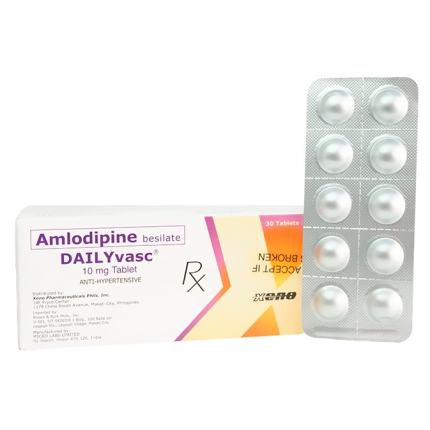Indications/Uses
Amlodipine is a dihydropyridine calcium-channel blocker and it is used in the management of hypertension and angina pectoris.
Dosage/Direction for Use
In hypertension the usual initial dose is 5 mg once daily, increased, if necessary, to 10 mg once daily. Similar doses are given in the treatment of stable angina and Prinzmetal's angina.
Or as prescribed by the physician.
Or as prescribed by the physician.
Administration
May be taken with or without food.
Contraindications
Amlodipine is contraindicated in patients with known hypersensitivity to Amlodipine.
Special Precautions
Should be used with caution in patients with hypotension, in patients whose cardiac reserve is poor, and in those with heart failure since deterioration of heart failure has been noted. It should not be used in cardiogenic shock, in patients who have recently suffered myocardial infarction, or in acute unstable angina.
Adverse Reactions
The most commonly observed side effects were dizziness, flushing, headache, hypotension, peripheral oedema, tachycardia, and palpitations. Nausea and other gastrointestinal disturbances, increased micturition frequency, lethargy, eye pain, and mental depression have also occurred. A paradoxical increase in ischaemic chest pain may occur the start of treatment and in few patients excessive fall in blood pressure has led to cerebral or myocardial ischaemia or transient blindness.
Storage
Store at temperatures not exceeding 30°C.
Action
Pharmacology: Amlodipine is a dihydropyridine calcium antagonist that inhibits the trans-membrane influx of calcium ions into the vascular smooth muscle and cardiac muscle. The mechanism of the antihypertensive action is due to a direct relaxant effect on vascular smooth muscle. The precise mechanism by which Amlodipine relieves angina may be due to the following two actions: 1. Amlodipine dilates peripheral arterioles and thus reduces the total peripheral resistance against which the heart works. Since there is no associated reflex tachycardia, this unloading of the heart reduces myocardial energy consumption and oxygen requirements and probably accounts for the effectiveness of Amlodipine in myocardial ischaemia.
2. The mechanism of action of Amlodipine probably involves dilation of the main coronary arteries and coronary arterioles, both in normal and ischaemic regions.
Pharmacokinetics: Amlodipine is well absorbed following oral administration of the therapeutic doses with peak blood concentrations occurring after 6 to 12 hours. The bioavailability is about 60 to 65%. It is reported to be about 97.5% bound to plasma proteins. It has a prolonged terminal elimination half-life of 35 to 50 hours and steady-state plasma concentrations are not achieved until 7 to 8 days of administration. Amlodipine is extensively metabolised to inactive metabolites in the liver; metabolites are mostly excreted in urine together with less than 10% of a dose as unchanged drug.
2. The mechanism of action of Amlodipine probably involves dilation of the main coronary arteries and coronary arterioles, both in normal and ischaemic regions.
Pharmacokinetics: Amlodipine is well absorbed following oral administration of the therapeutic doses with peak blood concentrations occurring after 6 to 12 hours. The bioavailability is about 60 to 65%. It is reported to be about 97.5% bound to plasma proteins. It has a prolonged terminal elimination half-life of 35 to 50 hours and steady-state plasma concentrations are not achieved until 7 to 8 days of administration. Amlodipine is extensively metabolised to inactive metabolites in the liver; metabolites are mostly excreted in urine together with less than 10% of a dose as unchanged drug.
MedsGo Class
Calcium Antagonists / Anti-Anginal Drugs
Features
Dosage
10 mg
Ingredients
- Amlodipine
Packaging
Tablet 1's
Generic Name
Amlodipine Besilate
Registration Number
DRP-832-01
Classification
Prescription Drug (RX)
Reviews
No reviews found
Product Questions
Questions

